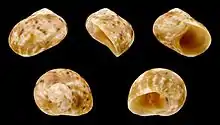Chrysostoma paradoxum
Chrysostoma paradoxum, common name the orange-mouthed top shell, is a species of sea snail, a marine gastropod mollusk in the family Trochidae, the top snails.[2][3]
| Chrysostoma paradoxum | |
|---|---|
 | |
| Five views of a shell of Chrysostoma paradoxum | |
| Scientific classification | |
| Domain: | Eukaryota |
| Kingdom: | Animalia |
| Phylum: | Mollusca |
| Class: | Gastropoda |
| Subclass: | Vetigastropoda |
| Order: | Trochida |
| Superfamily: | Trochoidea |
| Family: | Trochidae |
| Genus: | Chrysostoma |
| Species: | C. paradoxum |
| Binomial name | |
| Chrysostoma paradoxum | |
| Synonyms[2] | |
| |
Description
The length of the shell varies between 18 mm and 21 mm. The globular shell is imperforate or nearly so, thick and strong, with a porcelaneous texture. The surface of the shell is smooth, with scarcely visible lines of growth. The upper whorls are microscopically, and densely, spirally striated. The color of the shell is whitish, closely reticulated and mottled all over with red or pinkish, often with a few large darker maculations above. The spire is very short. The sutures are linear. They are bordered by a slight concavity of the whorl or margination. The six whorls are convex, the last globular. The aperture is half-moon shaped and has a reddish or golden-orange color within. The parietal wall is covered with a very thick orange-colored (rarely crimson) callus, which projects in a short tongue-shaped lobe above the slight, often closed, umbilical perforation.[4]
Distribution
This marine species occurs on corals in the intertidal zone of the East China Sea, off the Philippines, Japan, New Caledonia and Queensland, Australia.
References
- a Born, Ignatius (1780). "Helix Paradoxa". Testacea Musei Cæsarei Vindobonensis. Vindobonæ: Joannis Pauli Kraus. p. 394. Tab. 13, Fig. 16, 17.
- Bouchet, P. (2012). Chrysostoma paradoxum (Born, 1778). Accessed through: World Register of Marine Species at http://www.marinespecies.org/aphia.php?p=taxdetails&id=547321 on 2012-11-23
- Poppe G.T., Tagaro S.P. & Dekker H. (2006) The Seguenziidae, Chilodontidae, Trochidae, Calliostomatidae and Solariellidae of the Philippine Islands. Visaya Supplement 2: 1-228.
- Tryon (1889), Manual of Conchology XI, Academy of Natural Sciences, Philadelphia
- Crosse, H., 1866. Note complémentaire sur l'opercule du Chrysostoma nicobaricum . J. de Conch., 14:116-117
- Troschel, F.H., 1879. Das Gebiss der Schnecken, zur Begründung einer Natürlichen Classification [by J. Thiele]. Nicolaische Verlagsbuchhandlung, Berlin. 237.
- Watson, R.B., 1886 [31/Dec/1886]. Report of the Scaphopoda and Gastropoda. Rep. Scient. Res. Voy. HMS Challenger 1873-76.zoology, 15(42):0-0
- Schepman, M.M., 1908 [31/Dec/1908]. Prosobranchia (excluding Heteropoda and parasitic Prosobranchia). Rhipidoglossa and Docoglossa. With an appendix by Prof. R. Bergh [Pectinobranchiata].. Siboga Expedition, 49(1):1-1089
- Allan, J., 1950. Australian Shells, with related animals living in the sea, in freshwater and on the land. Georgian House, Melbourne. xix 470 pp
- MacNeil, F.S., 1960. Tertiary and Quaternary Gastropoda of Okinawa. U.S. Geol. S. Professional Pa., 339:0-0.
- Rippingale, O.H. & McMichael, D.F., 1961. Queensland and Great Barrier Reef Shells. Jacaranda Press, Brisbane. 210 pp.
- Habe, T., 1964. Shells of the Western Pacific in color II. Hoikusha, Osaka. 66 pls, 233.
- Hinton, A., 1972. Shells of New Guinea and the Central Indo-Pacific. Jacaranda Press, Milton
- Coleman, N., 1981. What shell is that ? Lansdowne Press, Sydney. 1-298.
- Wilson, B., 1993. Australian Marine Shells. Prosobranch Gastropods. Odyssey Publishing, Kallaroo, WA